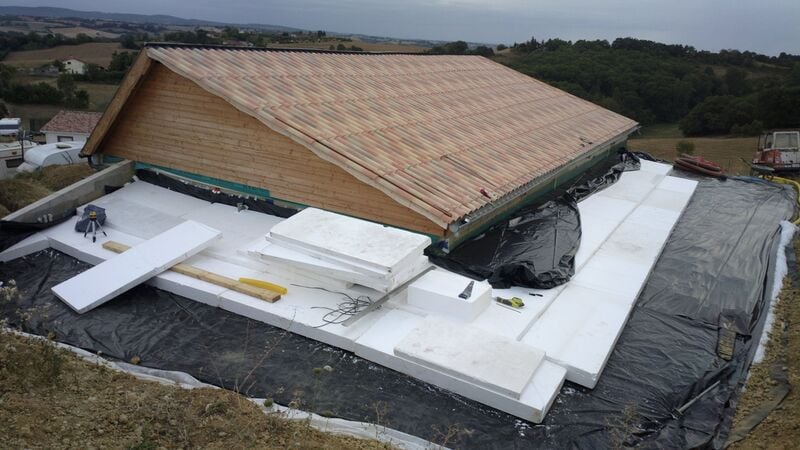Passive Annual Heat Storage (PAHS) is a building concept theorized to create a year-round constant temperature in an earth shelter by means of passive solar heating and a thermal battery effect lasting several months. It is claimed that an earth shelter designed according to PAHS principles would store the Sun's heat in the summer and release it slowly over the winter months without need for other forms of heating. This method was first described by inventor John Hait in his 1983 book.[1]
Description[edit | edit source]
The main component of PAHS is an insulated and waterproof "umbrella" which extends out from the earth shelter for several meters in all directions. The earth under this umbrella is kept warm and dry relative to surrounding earth, which is subject to constant daily and seasonal temperature changes. This creates a large heat storage area of earth, effectively a huge thermal mass. Heat is gained via passive solar in the earth shelter and transferred to the surrounding earth by conduction. Thus, because heat always moves toward colder areas, when the temperature in the home dips below the temperature in the surrounding earth, heat will return to the home.
Another feature of the PAHS system is the use of a coupled heat exchanging earth tube ventilation system which provides cooled fresh air in summer and warmed fresh air in winter.
Evidence[edit | edit source]
Hait's book contained a limited degree of scientific evidence regarding the efficacy of the building system such as dynamic heat flow computer simulations and a few example buildings where some of the PAHS principles had been applied. As of the 2013 revision, the textbook does not document a real world example of a PAHS earth shelter designed exactly as prescribed, or data relating to the performance of such a structure in the field.
The main source of evidence for the efficacy of PAHS is anecdotal, but a small number of owners have reported houses that are extremely comfortable year-round.
However, a recent documented low-cost (€100K) self-build in southern France has shown steady year-round indoor temperatures varying between 18C (64F) and 25C (77F) over a three-year period, fully confirming the validity of Hait's theories. The house is built into a south-facing slope and earth-protected on three-sides, with an insulated umbrella stretching out 6m (20 feet) all around the house (see photo). The house is unique in that almost all walls are made of rammed earth from the excavation, reinforced by concrete posts and beams.

Temperature data from the house can be seen here
Notes[edit | edit source]
- With adjustments, Hait claims that the PAHS technique could be applied to any climate, provided some degree of seasonal temperature change and enough sunny days in the warm season to allow heat collection. The PAHS concept would appear to be most appropriate for regions where the average temperature between cold and warm season is high enough that it approximates comfortable room temperature. It would not seem best suited to conditions where the average annual temperature was uncomfortably low, unless of course the passive effect is intended to be supplemented by another heating method.
- The size of the insulation / watershed umbrella suggested by Hait (6 meters) is based on a calculated "deep earth constant temperature" of 7 degrees Celsius at 6 meters in Montana, USA.[1] However this appears to vary based on geographic location. For example another source gives the deep earth constant temperature as 8 - 11° C at 15 meters.[2] It would follow that the size of the umbrella might need to be adjusted based on this.
References[edit | edit source]
External links[edit | edit source]
- Home in the earth (blog about building a PAHS house)
- Maison PAHS, la terre comme stockage inter-saisonnier de chaleur [2](illustrated blog including 3 years of thermal measurements of a succesful PAHS build).